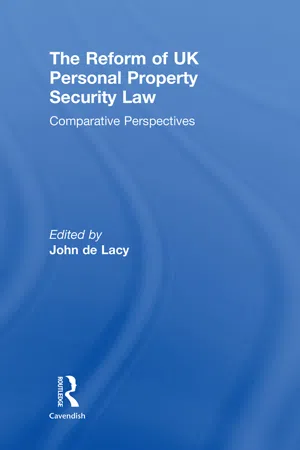
- 526 pages
- English
- ePUB (mobile friendly)
- Available on iOS & Android
About this book
There has been much discussion in the last ten years about the need to reform the law governing company charge registration, with many bodies including the Department of Trade and Industry and Law Commissions considering the case for reform of this area in the context of a wider scheme of personal property security reform. This has culminated in the coming into force of Part 25 of the Companies Act 2006, which is concerned with company charge registration.
This major book features the work of international experts on personal property security law. It focuses on the reform of UK company charge law and argues that the Companies Act 2006 did not go far enough in reforming the law. It addresses the question as to whether the UK should follow the lead of other jurisdictions that have adopted US Article 9 type personal property security schemes. As well as considering current UK law the book also addresses the changes proposed by the Law Commissions and, despite current government inaction, considers whether these reform proposals should be adopted.
The book contains major international comparisons and, in particular, looks at law reform in the USA, Canada, Australia, New Zealand, Singapore and Europe. This comparative treatment gives the reader a full perspective on this difficult and constantly developing area of law.
Frequently asked questions
- Essential is ideal for learners and professionals who enjoy exploring a wide range of subjects. Access the Essential Library with 800,000+ trusted titles and best-sellers across business, personal growth, and the humanities. Includes unlimited reading time and Standard Read Aloud voice.
- Complete: Perfect for advanced learners and researchers needing full, unrestricted access. Unlock 1.4M+ books across hundreds of subjects, including academic and specialized titles. The Complete Plan also includes advanced features like Premium Read Aloud and Research Assistant.
Please note we cannot support devices running on iOS 13 and Android 7 or earlier. Learn more about using the app.
Information
1
The evolution and regulation of security interests over personal property in English law
Introduction
The concept and meaning of ‘security interest’
The consensual security interest
Table of contents
- Contents
- Table of Statutes
- Table of Cases
- Notes on contributors
- Foreword
- Introduction
- 1 The evolution and regulation of security interests over personal property in English law
- 2 Pressured by the paradigm
- 3 A Canadian academic’s reactions to the Law Commission’s proposals
- 4 What is wrong with the law of security?
- 5 Exceptions to the nemo dat rule in relation to goods and the Law Commission’s proposals in the Consultative Report
- 6 Securities collateral
- 7 Security over moveables in Scots law
- 8 Security interests in intellectual property
- 9 Technology-based small firms and the commodification of intellectual property rights
- 10 The New Zealand Personal Property Securities Act 1999
- 11 Personal property security law reform in Australia
- 12 Personal property security interests in Singapore
- 13 Basic issues of European rules on security in movables
- 14 Key objectives and fundamental policies of the UNCITRAL Legislative Guide on Secured Transactions
- Appendix 1 Work of the Law Commissions of England and Wales and Scotland 2002–2005
- Appendix 2 Companies Act 2006 Part 25 Company charges
- Appendix 3 Companies Act 1985 Part XII Registration of charges
- Index